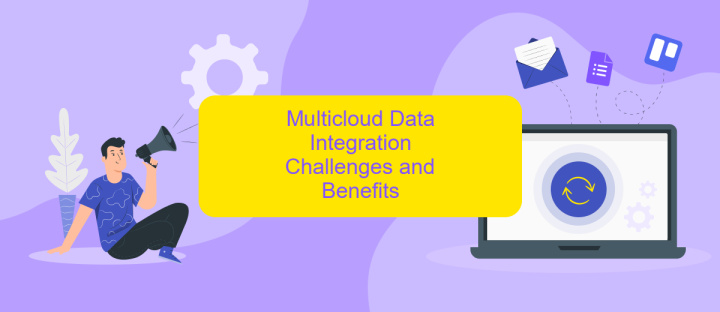Multicloud Data Integration
In today's rapidly evolving digital landscape, businesses are increasingly adopting multicloud strategies to optimize performance, enhance flexibility, and reduce risk. Multicloud data integration emerges as a critical component in this environment, enabling seamless data flow and collaboration across diverse cloud platforms. This article explores the key benefits, challenges, and best practices for effective multicloud data integration.
Executive Summary
Multicloud Data Integration is becoming increasingly critical as organizations adopt diverse cloud environments to enhance flexibility, scalability, and performance. Managing and integrating data across multiple cloud platforms presents unique challenges, requiring robust strategies and advanced technologies to ensure seamless data flow and consistency.
- Enhanced data accessibility and agility
- Improved disaster recovery and business continuity
- Optimized costs and resource allocation
- Increased compliance and security measures
- Facilitated innovation and competitive advantage
To achieve effective multicloud data integration, organizations must leverage tools that support interoperability, real-time data synchronization, and comprehensive monitoring. By addressing these aspects, businesses can unlock the full potential of their data assets, driving informed decision-making and fostering innovation in an increasingly competitive landscape.
Introduction

In today's rapidly evolving digital landscape, businesses are increasingly adopting multicloud strategies to leverage the unique strengths of different cloud platforms. Multicloud data integration is the process of seamlessly connecting, managing, and utilizing data across multiple cloud environments. This approach not only enhances data accessibility and flexibility but also ensures business continuity and disaster recovery. By integrating data from various cloud services, organizations can optimize their operations, improve decision-making, and drive innovation.
Effective multicloud data integration requires robust tools and solutions that can handle the complexities of diverse cloud ecosystems. ApiX-Drive is one such service that simplifies the integration process by providing a user-friendly platform for connecting various cloud applications and automating data workflows. With ApiX-Drive, businesses can easily synchronize data between different cloud services, reducing manual efforts and minimizing the risk of errors. This enables organizations to focus on their core activities while ensuring that their data is consistently accurate and up-to-date across all platforms.
Multicloud Data Integration Challenges and Benefits

Integrating data across multiple cloud platforms presents both significant challenges and notable benefits for organizations. On one hand, managing a multicloud environment can be complex, requiring robust strategies to ensure data consistency, security, and compliance. On the other hand, leveraging multiple cloud services can offer enhanced flexibility, redundancy, and specialized capabilities.
- Complexity: Coordinating data across various cloud providers demands sophisticated tools and expertise.
- Security: Ensuring data protection and privacy across different platforms can be challenging.
- Compliance: Meeting regulatory requirements in a multicloud setup requires diligent oversight.
- Flexibility: Utilizing multiple clouds allows for optimized performance and cost-efficiency.
- Redundancy: Multicloud strategies enhance data availability and disaster recovery options.
- Specialized Services: Access to unique features and services from different providers can drive innovation.
In conclusion, while multicloud data integration poses several hurdles, the potential advantages make it a compelling strategy for many businesses. By addressing the challenges with effective planning and technology, organizations can unlock substantial value and resilience in their data management practices.
Multicloud Data Integration Solutions and Best Practices

Integrating data across multiple cloud platforms presents unique challenges but also offers significant benefits. Effective multicloud data integration solutions ensure seamless data flow, enhance scalability, and improve data accessibility. Organizations must adopt best practices to navigate the complexities of multicloud environments successfully.
One crucial practice is leveraging cloud-agnostic tools and technologies that support various cloud providers. This approach minimizes vendor lock-in and enhances flexibility. Additionally, implementing robust data governance frameworks ensures data quality, security, and compliance across all cloud platforms.
- Utilize cloud-native integration services for seamless connectivity.
- Implement automated data synchronization to maintain consistency.
- Adopt a centralized monitoring system for real-time data tracking.
- Ensure strong encryption and access controls to protect data.
By following these best practices, organizations can efficiently manage data across multiple clouds, reducing operational complexities and enhancing overall data strategy. A well-architected multicloud data integration approach enables businesses to leverage the full potential of their data assets, driving innovation and competitive advantage.


Conclusion
In conclusion, Multicloud Data Integration is an essential strategy for modern enterprises aiming to leverage the full potential of their diverse data sources. By seamlessly connecting different cloud environments, organizations can enhance data accessibility, ensure better data governance, and drive more informed decision-making processes. The complexity of managing multiple cloud services can be significantly reduced with the right tools and platforms, enabling businesses to focus on their core objectives.
One such tool that stands out in facilitating these integrations is ApiX-Drive. This service simplifies the process of connecting various applications and platforms, ensuring smooth and efficient data flow across different cloud environments. By leveraging ApiX-Drive, organizations can automate data synchronization, reduce manual efforts, and significantly improve operational efficiency. As businesses continue to adopt multicloud strategies, leveraging robust integration tools like ApiX-Drive will be crucial in maintaining a competitive edge and achieving long-term success.
FAQ
What is Multicloud Data Integration?
Why is Multicloud Data Integration important?
What challenges are associated with Multicloud Data Integration?
How can businesses automate Multicloud Data Integration?
What are some best practices for Multicloud Data Integration?
Time is the most valuable resource in today's business realities. By eliminating the routine from work processes, you will get more opportunities to implement the most daring plans and ideas. Choose – you can continue to waste time, money and nerves on inefficient solutions, or you can use ApiX-Drive, automating work processes and achieving results with minimal investment of money, effort and human resources.

